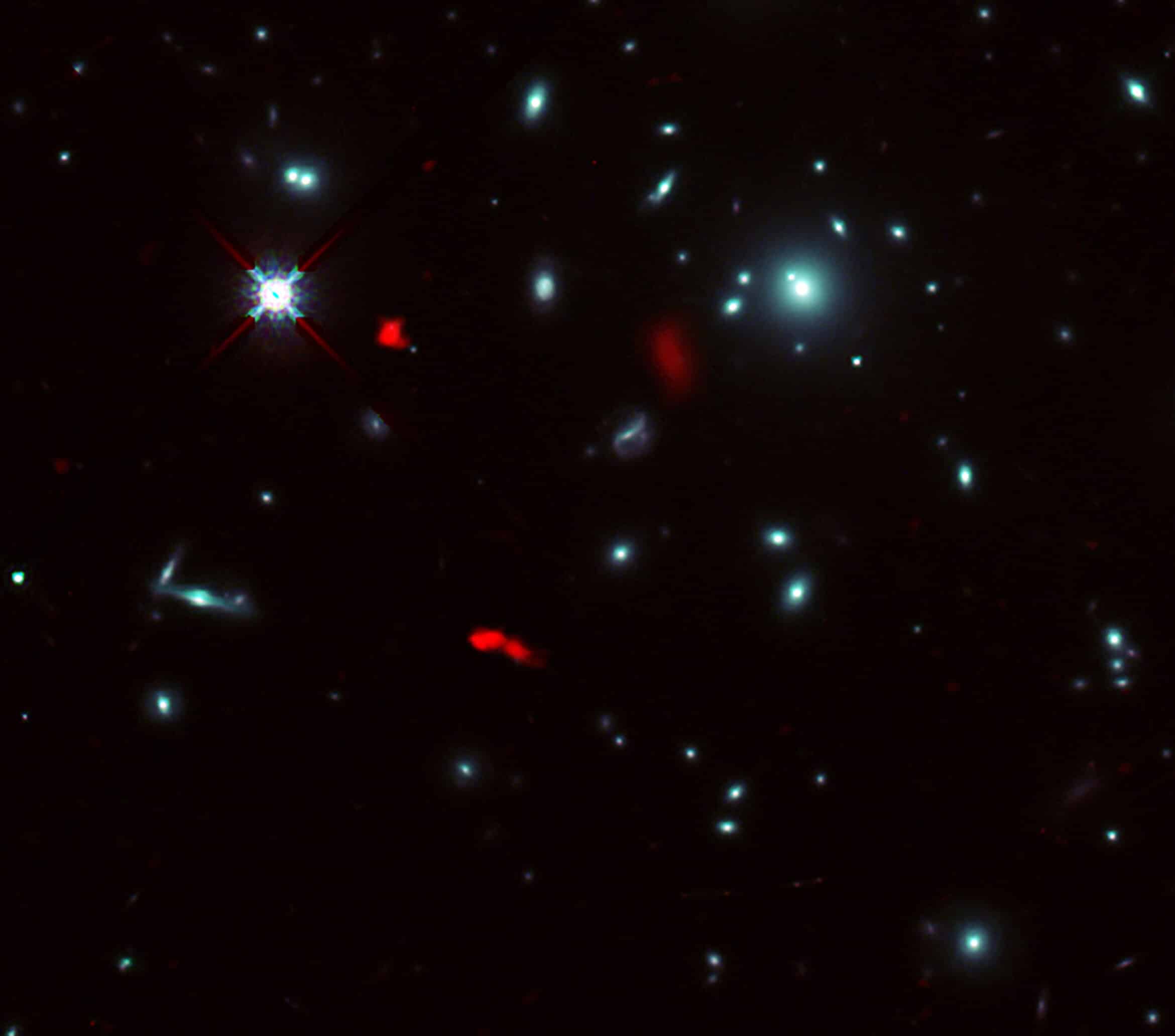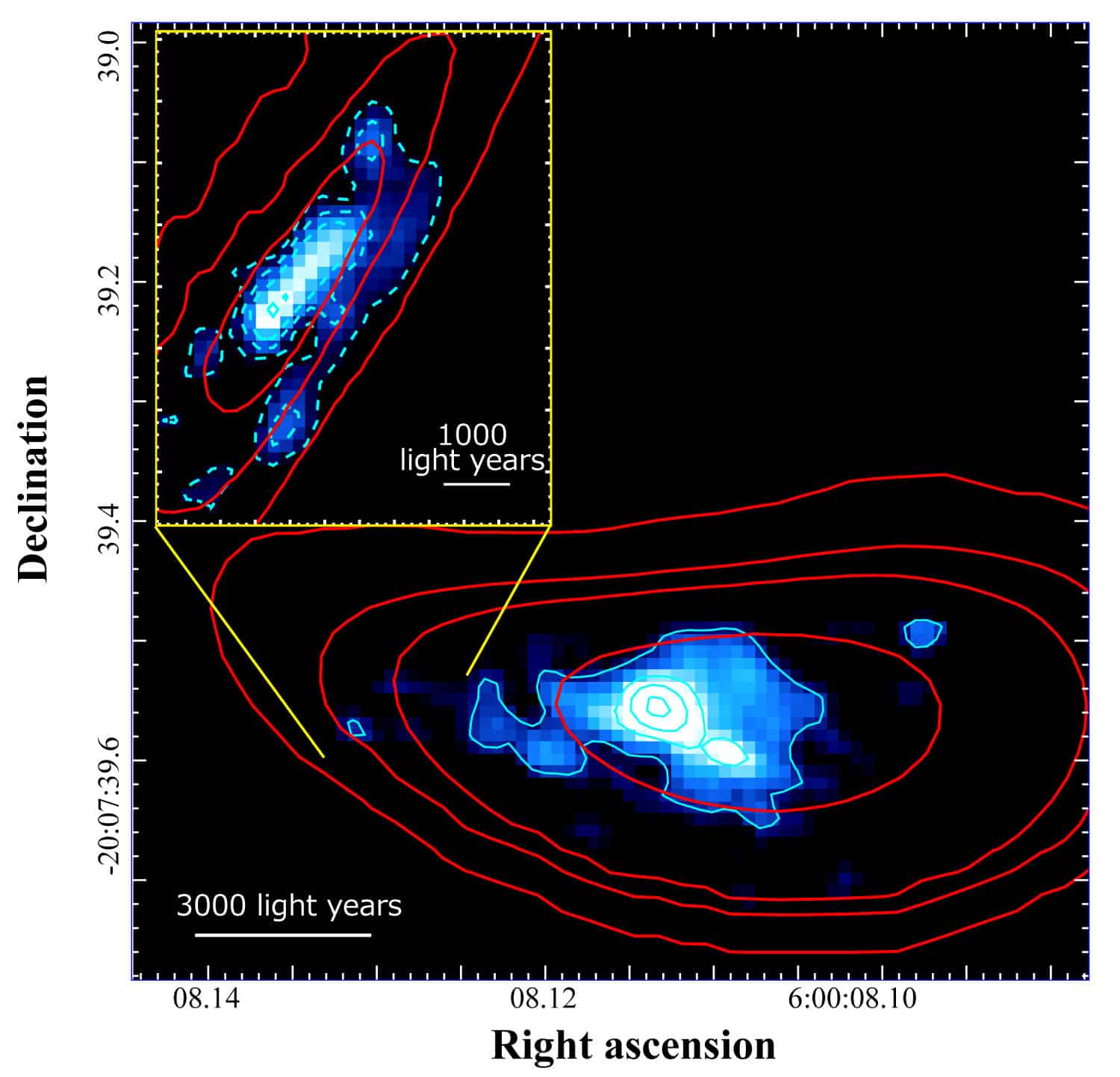Ben-Gurion University of the Negev is a partner in the discovery with the help of a computer model of gravitational lensing

An international group of astronomers discovered with the help of the ALMA radio telescope in the Atacama desert in Chile, a new rotating galaxy only a hundredth the size of the Milky Way. The infant galaxy is seen when the universe was only 7% of its current age. Thanks to the phenomenon of gravitational cooling, the team was able for the first time to study the nature of "normal galaxies" in the early universe - small and relatively "dark" galaxies, which represent the main population of the first galaxies. The discovery significantly helps to understand the first stages in the evolution of galaxies.
"Many of the galaxies in the early universe are so small and distant that they are not bright enough to be detected even by the largest telescopes on Earth or in space," said Nicolas Laporte, a senior fellow at the University of Cambridge. "However, the light coming from the galaxy named RXCJ0600-z6 has been greatly enhanced by gravitational recirculation, making it an ideal target for studying the properties and structure of typical infant galaxies."
Gravitational bending is a natural phenomenon in which light emitted from a distant object is "bent" by the gravitational field of a massive body such as a galaxy or galaxy cluster. The name "gravitational lensing" is derived from the fact that the gravitational field of the massive object acts like a lens. When we look through a gravitational lens, the light of distant objects intensifies and their shapes are stretched as if we were looking through a giant magnifying glass. That is, in fact it is a "natural cosmic telescope" in space.
The international collaboration ALMA Lensing Cluster Survey (ALCS) - uses the ALMA radio telescope to search for many galaxies in the early universe that are magnified by gravitational lensing. Due to the amplification from the dimming phenomenon, the telescope can actually see fainter galaxies.
Dr. Adi Tzitrin, a faculty member in the Department of Physics at Ben-Gurion University of the Negev, is a member of the ALCS international collaboration and among the leading authors of one of the discovery articles. "Our main contribution to the discovery was on two levels: first, we built a computer model for the gravitational lens with the help of which it was possible to analyze the impurity of the galaxy and learn about its internal characteristics. Secondly, spectroscopic observations of the galaxy from the Gemini telescope on the Mauna Kea mountain in Hawaii, helped us determine the distance to it and thus confirm the emission lines seen with the ALMA telescope.'
Why is it essential to study the faintest galaxies in the early universe?
Why is it essential to study the faintest galaxies in the early universe? Theoretical calculations and numerical simulations predict that most of the first galaxies, which formed a few hundred million years after the Big Bang, are small, and therefore pale. Although a number of galaxies in the early universe were previously observed, due to the capabilities of the telescopes those studied were limited to the most massive objects, and therefore the least representative galaxies in the early universe. The only way to understand the standard formation of the first galaxies and get a complete picture of galaxy formation is to focus on the fainter and more common galaxies.
The ALCS team carried out a large-scale observing program of 95 hours, a very long time on the ALMA telescope, to observe the central regions of 33 galaxy clusters that form gravitational lenses. One of the clusters, RXC0600-2007, is located in the direction of the constellation "Rabbit", and has a mass of one million billion times (10^15) the mass of our Sun. The team discovered with ALMA one distant galaxy affected by this "natural telescope". The detection of the light from carbon ions and star dust in the galaxy, combined with data taken from the Gemini telescope, determined that the galaxy appears about 900 million years after the big bang (12.9 billion years ago). Analysis using the gravitational lensing model suggested that part of this source appeared 160 times brighter than it would have appeared without gravitational lensing.
By accurately mapping the mass distribution in the galaxy cluster, it is possible to "cancel" the gravitational dusting effect and restore the original appearance of the magnified object. By combining data from the Hubble Space Telescope and the European Southern Observatory's Very Large Telescope together with the theoretical model, the team was able to reconstruct the actual shape of the distant galaxy RXCJ0600-z6. The total mass of this galaxy is about 2 to 3 billion times the mass of our Sun, about 1/100th that of our Milky Way galaxy.
What amazed the team is that the RXCJ0600-z6 rotates. Traditionally, gas in young galaxies is thought to have random and chaotic motion. Only recently did researchers discover a number of young, more regularly rotating galaxies that challenged the traditional theoretical framework, but these were brighter (and larger) than RXCJ0600-z6.
"Our study demonstrates, for the first time, that we can directly measure the internal motion of such faint (less massive) galaxies in the early universe, and compare them with the theoretical predictions," says Kotaro Kohno, a professor at the University of Tokyo and the leader of the ALCS team.

The fact that RXCJ0600-z6 is highly amplified makes us develop expectations for future research," explains Seiji Fujimoto from the Niels Bohr Institute. "This galaxy has been selected, along with several hundred other galaxies, for observation by the James Webb Space Telescope (JWST), the next-generation space telescope that will be launched this fall. Through joint observations with ALMA and JWST, we will reveal the properties of gas and stars in the young galaxy and its internal motions. When the construction of giant telescopes such as the Thirty Meter Telescope and the Extremely Large Telescope is completed, they will be able to detect star clusters in this galaxy and perhaps even find individual stars. There is currently an example of gravitational acceleration that helped to see a single star at a distance of 9.5 billion light years, and this research has the potential to even increase this range to at least the first billion years of the universe.'
"It's great to see the science made possible with the help of the gravitational cooling phenomenon in recent years," concludes Dr. Tzitrin. "Using the dimming phenomenon, particularly with new telescopes currently under construction such as the James Webb Space Telescope (JWST), will surely lead to more new and exciting discoveries in the coming years."
The data from the Gemini telescope used in the research was obtained through an agreement between the Association of Universities for Research in Astronomy, Inc. (AURA - the Association of Universities for Research in Astronomy, Inc.) and Ben-Gurion University of the Negev.
The research was supported by the Association for the Promotion of Science in Japan, KAKENH, the Joint Scientific Research Program of the European Research Council (ERC) within the European Union's Research and Innovation Program 2020, the Independent Research Foundation Denmark, the Danish National Research Foundation, the Kavli Foundation, ANID, the Millennium Science Initiative, the Research Council The Swedish and Keren Knut and Alice Wallenberg. This work was supported in part by the Joint Research Program of the Institute for Cosmic Ray Research (ICRR), University of Tokyo.
The Atacama Large Millimeter / Submillimeter Array (ALMA), an international astronomy facility, is a partnership of the European Southern Hemisphere Astronomical Research Organization (ESO), the US National Science Foundation (NSF) and the National Institutes of Natural Sciences (NINS) of Japan in collaboration with the Republic of Chile. ALMA is funded by ESO on behalf of its member countries, by NSF in cooperation with the National Research Council of Canada (NRC) and the Ministry of Science and Technology (MOST) and by NINS in cooperation with the Academia Sinica (AS) in Taiwan and the Korea Astronomy and Space Science Institute (KASI). The construction and operation of ALMA is managed by ESO on behalf of its member states; by the National Radio Astronomy Observatory (NRAO), operated by Associated Universities, Inc. (AUI), on behalf of North America; and by the National Astronomical Observatory of Japan (NAOJ) on behalf of East Asia. The Joint ALMA Observatory (JAO) provides the unified leadership and management of the establishment, commissioning and operation of ALMA.
More of the topic in Hayadan:
- Comets as factories for the production of organic molecules
- A galaxy cluster that is also a giant gravitational lens
- The Technion will award the Gamunder prize for the development of space technologies for the development of a space telescope based on liquid lenses
- Five ways artificial intelligence can help space exploration
- Biomimetic lens
